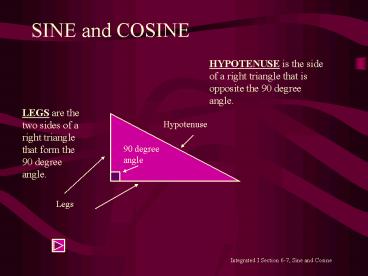SINE and COSINE - PowerPoint PPT Presentation
1 / 13
Title:
SINE and COSINE
Description:
The Hypotenuse is always the side opposite the 900 angle. It will also be the longest side. ... The Ratio will always be Leg opposite the Reference Angel / Hypotenuse. ... – PowerPoint PPT presentation
Number of Views:54
Avg rating:3.0/5.0
Title: SINE and COSINE
1
SINE and COSINE
HYPOTENUSE is the side of a right triangle that
is opposite the 90 degree angle.
LEGS are the two sides of a right triangle that
form the 90 degree angle.
Hypotenuse
90 degree angle
Legs
Integrated I Section 6-7, Sine and Cosine
2
SINE and COSINE
More Definitions
REFERENCE ANGLE One of the two acute angles
Now lets see if you can use them
Integrated I Section 6-7, Sine and Cosine
3
SINE and COSINE
Answer using the letters from the diagram below.
1. Identify the legs of . the
triangle. A. a and c B. b and a C. B
and a D. A and C
Push the space bar when you have your answer.
B is the correct answer. b and a are the legs of
the triangle. The legs will always touch the 90o
angle.
Integrated I Section 6-7, Sine and Cosine
4
SINE and COSINE
Answer using the letters from the diagram below.
2. Name the angles that may be used as reference
angles. A. A and B B. A and C C. B and C D. B
and b
Push the space bar when you have your answer.
Angles A and B are the only two that may be used
as reference angles. The 90o angle will never be
used.
Integrated I Section 6-7, Sine and Cosine
5
SINE and COSINE
Answer using the letters from the diagram below.
3. Name the . Hypotenuse. A.
A B. c C. b D. a
Push the space bar when you have your answer.
The Hypotenuse is always the side opposite the
900 angle. It will also be the longest side.
The answer is B
Integrated I Section 6-7, Sine and Cosine
6
SINE and COSINE Ratios
sin A leg opposite / A . Hypotenuse
A is the reference angle
b is the leg opposite
c is the hypotenuse
BC AB
Therefore the ratio
Integrated I Section 6-7, Sine and Cosine
7
SINE and COSINE
Lets try a few.
With A as my reference angle, what is the Sine
ratio?
Push the space bar when you have your answer.
BC
AB
Integrated I Section 6-7, Sine and Cosine
8
SINE and COSINE
Lets try a few.
With B as my reference angle, what is the Sine
ratio?
Push the space bar when you have your answer.
Hypotenuse
Opposite
AC
Opposite
AB
Hypotenuse
Integrated I Section 6-7, Sine and Cosine
9
SINE and COSINE
Remember, the reference angle may change but the
Sine Ratio will always be
Leg Opposite
Sine of the Reference Angle
Hypotenuse
Integrated I Section 6-7, Sine and Cosine
10
SINE and COSINE
That was the Sine Ratio. The Ratio will always
be Leg opposite the Reference Angel / Hypotenuse.
Now we need to look at the Cosine Ratio. It is
similar to the Sine because it needs a Reference
Angle. It is different because the Cosine Ratio
is the Leg Adjacent to the Reference Angle /
Hypotenuse.
Integrated I Section 6-7, Sine and Cosine
11
SINE and COSINE Ratios
cos A leg adjacent / A . Hypotenuse
A is the reference angle
b is the leg adjacent
c is the hypotenuse
AC AB
Therefore the ratio
Integrated I Section 6-7, Sine and Cosine
12
SINE and COSINE Ratios
Some things to notice
The reference angle can be either A or B,
therefore you have to tell which one youre using.
The hypotenuse will always be the side opposite
the 900 angle.
Adjacent means the leg touching the reference
angle
The Legs of a Right Triangle are the two sides
that form the 900 angle
Opposite means the leg not touching the reference
angle.
Integrated I Section 6-7, Sine and Cosine
13
SINE and COSINE
Integrated I Section 6-7, Sine and Cosine































